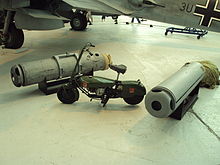Central Landing Establishment
53°21′11″N 2°16′23″W / 53.353°N 2.273°W The Central Landing Establishment was the Second World War British development centre for airborne warfare at RAF Ringway airfield near Manchester.[1]
Establishment
[edit]
Following Prime Minister Winston Churchill's decision to create a parachute corps within the British Army after German successes using airborne force during the early stages of the war, a parachute training school known as the Central Landing School was set up at RAF Ringway near Manchester in June 1940.[2] On 31 August 1940, it was expanded within the school becoming the Central Landing Establishment.[3] There was a separate Technical unit and the addition of the Glider Training Squadron which would be used by pilots training for the Glider Pilot Regiment.[4]
The centre was operated by Royal Air Force and British Army officers working in collaboration.[1]
In 1941, the Airborne Forces Establishment was created from the experimental and technical units, renamed in 1942 as the Airborne Forces Experimental Establishment.[5] The Parachute Training Squadron became a unit in its own right as the Parachute Training School on 15 February 1942.[6]
Glider pilot training took 24 weeks; a 12-week light pilot training course and a 12-week glider course.
Equipment
[edit]
The CLE developed equipment to be used by Britain's airborne forces, such as standardized equipment containers for parachuting supplies.
The Mark III CLE Canister was 6 feet (180 cm) long and 15 inches (38 cm) in diameter, with a 10-to-16-foot (3.0 to 4.9 m) parachute attached to one end and an impact absorbing "pan" at the other; the capacity was 600 pounds (270 kg). It split longitudinally for unloading.[7] These containers would fit in the bomb bays of aircraft making resupply easier. The largest CLE canister was 3.3 m long.
An earlier Mark I canister was D-shaped in cross-section (about 15 inches in diameter). A motorcycle, the "Welbike" was developed that could be stowed in one. A cylindrical fuel can was also developed to fit the CLE Canister, with a canister able to accommodate three of the cans.[8]
Other means of landing supplies were developed. Wicker baskets for some materiel, crates for motorcycles such as the Royal Enfield WD/RE, and the means of parachuting jeeps and light artillery pieces.
Staff
[edit]- Wing Commander Nigel Norman: Commandant 1940–1942
Notes
[edit]- ^ a b Thompson 1989, p. 4.
- ^ Harclerode 1992, p. 19.
- ^ Sturtivant, p 88
- ^ Harclerode 1992, p. 5.
- ^ "Central Landing Establishment RAF | ParaData". Archived from the original on 27 July 2010. Retrieved 8 April 2009.
- ^ Airborne Forces Units & HQs Archived 30 July 2012 at archive.today
- ^ Fowler, Will D-Day the first 24 hours 2003 Spellmount
- ^ "British Airborne Fuel Can". Summer Of 44. Retrieved 25 December 2012.
References
[edit]- Harclerode, Peter. (1992) Para! Fifty Years of the Parachute Regiment. Orion: London. ISBN 0-7528-0395-6.
- Sturtivant, Ray. (1997). Royal Air Force Training and Support Units. Air-Britain (Historians) Ltd. ISBN 0-85130-252-1.
- Thompson, Leroy. (1989). British Paratroops in Action. Combat Troops # 9. Squadron/Signal Publications: Carrollton, United States. ISBN 0-89747-233-0.
